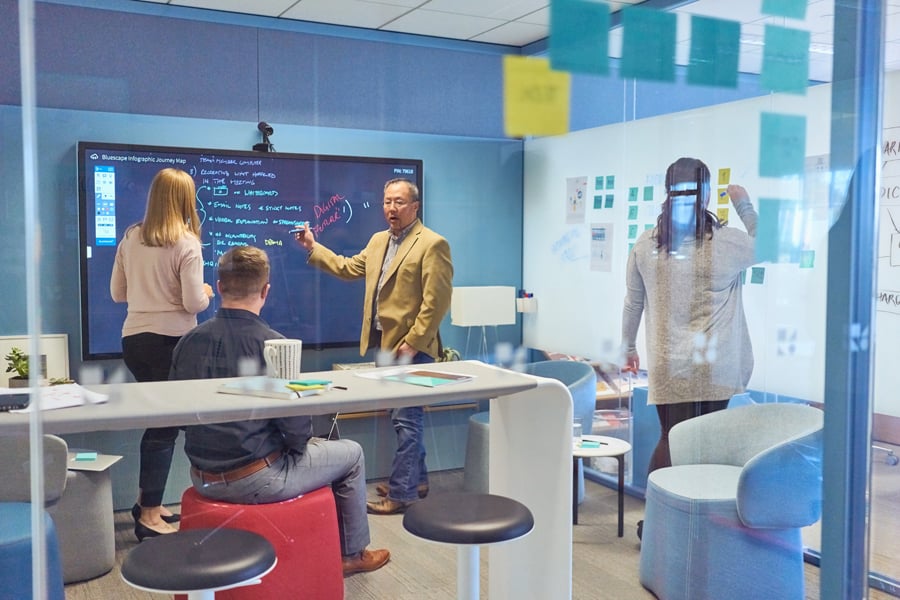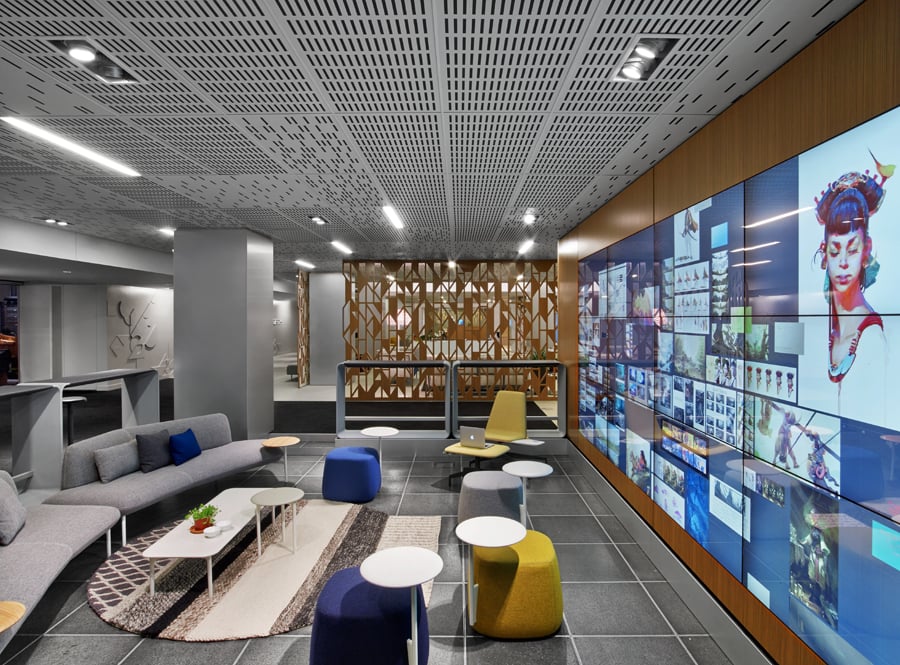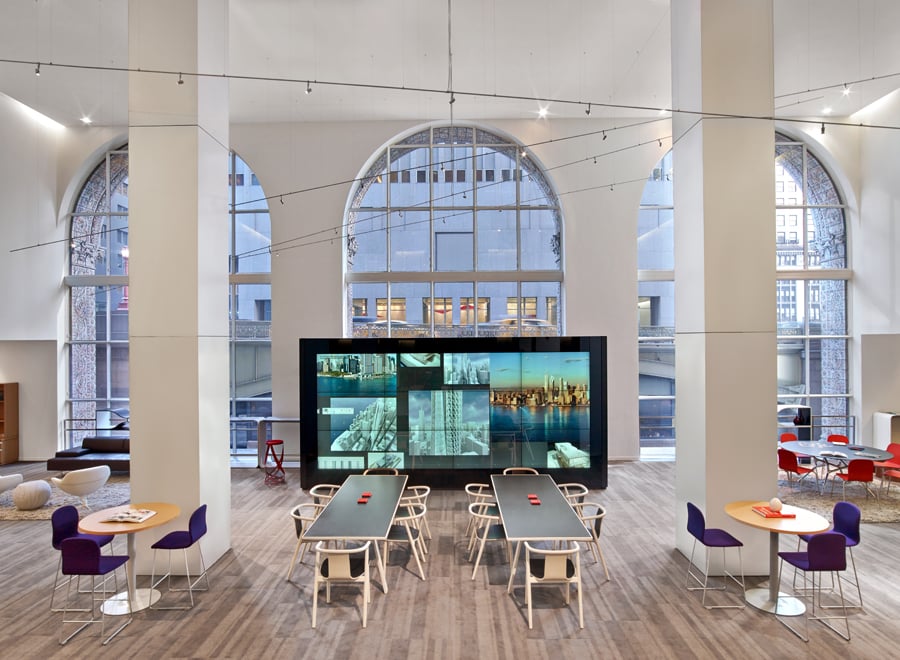
June 8, 2018
Channeling Minority Report, This Touchscreen Technology Promises More Connectivity Than Ever Before
Bluescape, a forward-thinking visual collaboration technology from Haworth promises to make authentic, productive interactions easy.

Back in the early 2000s, Jeff Reuschel had a wild idea. Reuschel, the global director of design and innovation at Haworth, wanted to see his team’s entire portfolio of work at once, spread out before him like a desktop covered in papers—only minus the desktop and minus the papers. Reuschel wondered: Instead of looking at Word documents, InDesign files, spreadsheets, and scraps of notes in their digital silos, could he project these related bits of information onto a wall simultaneously? And better yet, could he manipulate those files with his hands as if they were physical objects?
The answer to both questions was a resounding no. Reuschel’s concept was ahead of its time. In the early 2000s, projection technology was becoming more sophisticated, but touchscreens were still nascent. “What I ended up doing was taking a lot of little cards and push-pinning them to the wall,” he recalls.
A handful of years later, smartphones and tablets had become commonplace, and the same touch-screen technology that powered those smaller devices could be blown up to wall size. “They have set us free to operate in much more creative and innovative ways,” says Haworth’s chairman emeritus, Dick Haworth. “They’ve dramatically changed the footprint of the office.” So under his direction, Reuschel, alongside a team of engineers and designers, set out to make software that would power the workplace of the future. Their vision: an interactive wall that displays Word documents, spreadsheets, images, and notes, and can be projected onto a touchscreen surface that employees—both on-site and remote—are able to manipulate in real time, as if they’re using a giant tablet. They called this technology for visual collaboration Bluescape.

One can think of Bluescape as an amalgamation of past and current workplace productivity tools. “To me it’s a merger of tackboard, a whiteboard, an internet interface, and my desktop files,” Reuschel says. And like his description suggests, it’s part of a long lineage of tools that over the decades have helped employees work together. If you trace it back, there’s a path from pinboards and chalkboards to whiteboards and Post-It notes. Those low-fi tools were the conceptual precursors to software applications like Slack and Google Docs, which now allow employees to work together even when they’re geographically apart.
For Dick Haworth, who has been with the company for over 50 years, suddenly the need for cross-continental communication was crucial. “We were trying to figure out how to work efficiently and effectively,” he recalls. “The issues are quite different when you’re in one physical space versus an organization that’s spread around the world.”
Haworth’s remote-working conundrum is familiar to most modern companies today. Over the last decade, the office has dematerialized—or at the very least, vastly shifted in appearance—as more employees are able to work from disparate locations thanks to technologies like Slack and Bluescape. Often, the trajectory of workplace technology is reflected in the office design itself. Closed-door offices and cubicles gave way to open floor plans, and open floor plans in turn gave way to huddle rooms and unassigned seating. Today, it’s common for offices to build out communal workspaces where employees can take their laptops and gather in small groups to do work, but not provide them with desks they can claim as their own. It’s a shift enabled by technology, which has made people available and easy to find no matter where they may actually be. “That’s sort of the expectation now,” says Kasia Maynard, a researcher at the consultancy Worktech Academy. “You should have connectivity wherever you are.”

A couple of years ago, Boston Consulting Group moved from its midtown Manhattan offices to a new building in the Far West Side neighborhood of Hudson Yards. The new space was built to reflect the modern workplace, which is to say there are virtually no private offices. Instead, employees gather in communal spaces like a café or a long bench table that are designed to encourage “spontaneous collaboration.” They can book private rooms or temporarily be assigned a desk through an app, but there’s no sense in bringing a family portrait to work—no one owns any of the space.
Maynard refers to this as “activity-based working,” where employees meet in spaces that fit their specific needs at the moment. Need to meet with a team? Book a conference room. Need to be heads down on a deadline? Nab a desk. “When collaborating, you might go off to a huddle space, do some work, and then go your own way,” she says. “We’re not just with our teams anymore; we’re mixing with all different types of people all the time.”

For designers, this has necessitated a new way of thinking about office space. More general seating and common spaces are a given, but even tried-and-true work requirements like conference rooms are changing. Scott Poulton, Haworth’s vice president of strategic ventures and chairman of Bluescape, says he’s seen the design of the conference room morph from a stationary box with a door into something more dynamic that encourages employees to get up, move around, and interact with the environment. “A traditional conference room would be a large room with a big table in the center and maybe a 70-inch flat screen that everyone looks at,” he says. “In the future, the environment itself will be interactive.”
For Dick Haworth, the future is, to some degree, already here. He likens Bluescape to a “world” that multiple team members, thousands of miles apart, can inhabit: “You can brainstorm a project, and then you can begin to work on individual elements of it before implementing and managing those things—the details are all there in this vast space, but in a much more transparent way that enables different team members to easily follow what’s going on in different parts of a project.”
If technologies like Bluescape, Slack, and Google Docs are effectively proxies for in-person interaction; if their aim is to make collaborating with your coworker overseas just as compelling as collaborating with the person next to you, what’s the point of investing in a conference room at all? For some companies, the office will indeed become obsolete. But for Reuschel and Haworth, these advances are a reminder that while technology has enabled personal desks to disappear and offices to shrink, it has also made working together in the same space more rewarding. “I would say we’re getting awfully close to being able to work from anywhere,” Reuschel says. “But right now, I don’t think we’re there yet.”
Recent Viewpoints
Viewpoints
Sustainability News Updates for Q2 2025





